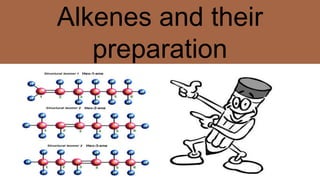
Alkenes and their preparation-HYDROCARBONS PART 2
- 2. Alkenes are unsaturated hydrocarbons containing carbon-carbon double bond (C═C)in their molecules. They have the general formula CnH2n. The simplest member of alkene family is ethene, C2H4. The alkenes are also called olefins (Greek olefiant meaning oil forming) because the larger member of the series (such as ethylene, propylene, etc react with chlorine to form oily products.
- 4. Alkynes can be reduced to alkenes using palladium charcoal (palladised charcoal) catalyst partially deactivated with poison like sulphur compounds or quioline. Partially deactivated palladised charcoal is known as Lindlar’s catalyst. Alkynes can also be reduced to alkenes with sodium in liquid ammonia which is called Birch reduction. For eg: CH3−C≡C−CH3 Pd- C, H 2 CH3CH═CHCH3 But-2-yne But-2-ene CH3–C≡CH+H2 CH3–CH=CH2 Propone Propene CH≡CH+H2 Pd/C CH2=CH2 Ethyne Ethene
- 5. Alkene can be prepared from alkyl halides(usually bromides or iodides) by treating with alcoholic potash(potassium hydroxide dissolved in ethanol). This reaction removes a molecule of HX and therefore, the reaction is called dehydrohalogenation. In this reaction, the hydrogen atom is eliminated from β carbon atom (carbon atom next to the carbon to which halogen is attached). Therefore, the reaction is also called β– elimination reaction. Nature of halogen atom and the alkyl group determine rate of the reaction. It is observed that for halogens, the rate is: Iodine>Bromine>Chlorine while for alkyl group it is Tertiary> Secondary>Primary.
- 6. Dihalogen derivatives of alkanes in which two halogens atoms are attached to adjacent carbon atoms (called vicinal dihalogen derivatives) are converted to alkenes by heating with zinc dust in ethyl alcohol. For eg: CH3CHBr−CH2Br+Zn CH3CH=CH2+ZnBr
- 7. Alkenes are prepared from alcohols by heating with protonic acids such as sulphuric acid at about 443K. This reaction is called dehydration of alcohols CH3CH2OH H2SO4 or H3PO4 CH2=CH2+H2O This reaction is also an example of β-elimination reaction because –OH group takes out one hydrogen atom from the β- carbon atom.
- 8. Alkenes add up on molecule of dihydrogen gas in the presence of finally divided nickle, palladium or platinum to form alkanes. Halogens like bromine or chlorine add up to alkene to form vicinal dihalides. The reddish orange colour of bromine solution in carbon tetrachloride is discharged when bromine adds up to an unsaturation site. This reaction is used as a test for unsaturation. Addition of halogen to alkene is an example of electrophilic addition reaction. Hydrogen halides (HCl, HBr, HI) add up to alkenes to form alkyl halides. The order of reactivity of the hydrogen halides is HI>HBr>HCl. Like addition of halogens to alkenes, addition of hydrogen halides is also an example of electrophilic addition reaction
- 9. Effect of Addition of halogens
- 10. Addition of HBr to symmetrical alkenes • Addition reactions of HBr to symmetrical alkenes take place by electrophilic addition reactions where similar groups are attached to the double bond. CH2=CH2 +H–Br ⎯⎯→CH3–CH2 –Br CH3 –CH=CH–CH3 +HBr ⎯→CH3 –CH2 –CH-CH3 | Br
- 11. Addition of HBr to symmetrical alkenes • When HBr is added to propene then it yields 1-bromopropane and 2-bromopropane
- 12. The markovnikov’s rule Markovnikov, a Russian chemist made a generalisation in 1869. these generalisation led Markovnikov to frame a rule call Markovnikov rule. The rule stated that: “During the addition across unsymmetrical multiple bond, the negative part of the addendum (attacking molecule)joins with the carbon atom which carries smaller number of hydrogen atoms while the positive part goes to the carbon atom with more hydrogen atom.” Vladimir markovnikov
- 13. Mechanism of markovnikov’s rule
- 14. The secondary carbocation is more stable than the primary carbocation , therefore, the former predominates because it is formed at a faster rate. • The secondary carbocation is attacked by Br– ion to form the product as follows :
- 15. Kharash's effect or peroxide effect or anti markovnikov’s rule • In the presence of peroxide, addition of HBr to unsymmetrical alkenes like propene takes place contrary to the Markovnikov rule. This happens only with HBr but not with HCl and Hl. • This reaction is known as peroxide or Kharash effect or MORRIS SELIG
- 16. REACTION OF ANTI MARKOVNIKOV’S RULE The reaction for anti markovnikov’s rule is as follows:-
- 17. MECHANISM FOR ANTIMARKOVNIKOV’S RULE • Step 1:- • Step 2 :-
- 18. • Step 3 :- • Step 4 :-
- 19. • The last step shows that 2-bromopropane is obtained as the minor product. • The peroxide effect is not observed in addition of HCl and HI. This may be due to the fact that the H–Cl bond being stronger than H–Br bond is not cleaved by the free radical, whereas the H–I bond is weaker and iodine free radicals combine to form iodine molecules instead of adding to the double bond.
- 20. Addition of sulphuric acid • Cold concentrated sulphuric acid adds to alkenes in accordance with Markovnikov rule to form alkyl hydrogen sulphate by the electrophilic addition reaction.
- 21. Addition of water • In the presence of a few drops of concentrated sulphuric acid alkenes react with water to form alcohols, in accordance with the Markovnikov rule.
- 22. Oxidation Alkenes react with cold dilute aqueous or alkaline potassium permanganate solution to form 1,2-diols called glycols. The glycols contain two –OH groups on adjacent carbon atoms This reaction of addition of two hydroxyl groups to each end of double bond is called hydroxylation of the double bond.
- 23. ozonolysis Alkenes are oxidised with ozone to form ozonides which are unstable compounds. These are reduced with zinc and water forming aldehydes and ketones. The reaction is called ozonolysis.
- 24. Polymerisation Polymerisation is a process in which a large number of simple (same or different) molecules combine to form a bigger molecule of higher molecular mass. The small molecule are called monomers while the bigger molecule are called macromolecules or polymers.
